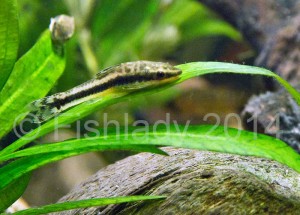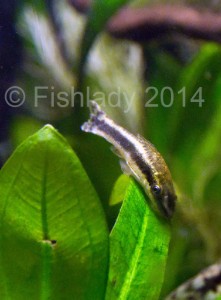Algae eaters are often considered the solution to algae in the aquarium. Algae is a common problem to many people, especially in newly set up aquariums. A frequent “answer” to this is to go to the aquarium shop and ask for “a fish that cleans up the algae” or an “algae eater”. This is something that requires a fair bit more consideration than it may seem as there are a few problems with this. This article will take you through some of the things you need to consider before deciding whether or not an algae eater is the right addition to your aquarium.
Why is there algae in the tank in the first place?
It’s important to understand why your tank is affected by algae. This will help you treat the cause as well as the symptom. Adding an algae eater doesn’t actually solve the problem of why there is algae in the tank. Algae is usually caused by a combination of a lot of nutrients and a lot of light in the tank or another imbalance in the little ecosystem. If there are too many nutrients in the tank then adding another fish isn’t really going to help as the fish will produce more waste, which is nutrition for algae. Certain species of fish often sold as algae eaters are renowned for producing huge amounts of waste due to the nature of their diets. Below is a picture of one night’s worth of ‘output’ from Hermione, the common pleco! That’s her tail in the background.

Algae in the tank is not necessarily a cause for panic. For example, one of the most common forms of algae is diatom algae, or brown algae. This is common in newly set up aquariums and often goes away of its own accord as the aquarium matures. It is easy to clean off yourself with a brush or sponge. This is often far more effective than getting a fish to do the job, it’s not easy to explain your requirements to a fish so you don’t always get the job you wanted done.
This guide will help you with some of the common causes of algae and how to rectify them.
Will I need to feed my algae eater? If so, what?
Assuming the fish is successful in removing the algae, it will need to be fed. A lot of people believe that because these fish eat algae, they don’t need to be fed anything else and will simply survive on the algae in the tank. Nothing could be further from the truth. Because algae is very low in nutrition, the fish needs to eat a lot of it. Once the tank is relatively free from algae, the fish will need to be fed a lot of extra food to supplement its diet. It’s also worth noting that very few species of fish eat all types of algae. So there will probably still be some algae growing somewhere in the tank. This is not a reason to say “Well, there’s still algae in the tank, I don’t need to feed my algae eater”, or to say “let’s get yet another fish to eat the other type of algae”!
There is some evidence to suggest that poorly fed algae eaters are more likely to try to feed on the sides of other fish. Evidence suggests that they attack the slime coat as they are looking for nutrients and will attach to the sides of other fish to try to feed on this.
Some people believe that “Because it’s got a suckermouth, it will eat algae”. There are many kinds of suckermouth fish that will not live on algae, not even survive on it. A suckermouth is much more a sign of the type of water they live in – fast flowing water, where the suckermouth is a way to maintain their position in the flow without having to swim – not a sign of their diet. Sure, many types of these fish do indeed feed at least partly on algae, but many others are not at all algae eaters. For example, Panaque nigrolineatus eats wood, and will not clean algae from glass or stone. Leporacanthicus triactis is a carnivore, which will feed on mussels, crustaceans and freshwater sponges, and not touch algae at all.
This means it’s important to be sure what diet your algae eater actually needs. As mentioned above, the suckermouth alone is not an indicator that the fish feeds exclusively on algae. We recommend you check the requirements for your fish against the species listed in my article on planetcatfish: Shane’s World Catfishology Feeding Plecos, Part 2 • Who eats what? If you are not completely sure what species you have please feel free to post on the planetcatfish forums for further information and we will try to identify your fish for you.
Once you are confident that you know what your fish is, and what it prefers to eat, you might like to take a look at my other article which gives more details on what you can feed your algae eater: Shane’s World Catfishology Feeding Plecos, Part 1 • Types of food
It’s worth bearing in mind that the foods suitable for supplementing the diet of suckermouth algae eaters are also suitable for supplementing the diets of other types of algae eater.

Is the algae eater suitable for your aquarium and is your aquarium suitable for the algae eater?
Many so called algae eaters live in water that is quite fast flowing. This means they need reasonably high flow in the aquarium that we make their home. Low oxygen levels and dirty water are very likely to kill these fish.
Hillstream loach species are frequently sold as algae eaters for coldwater or temperate tanks. They are also known as Hong Kong plecs, butterfly plecs and Borneo suckerfish among other common names. These fish have very specific requirements and are best suited to set ups with very high flow. There is an excellent article on loaches.com which gives some great information on the requirements of these fish – Hillstream loaches – the specialists at life in the fast lane.
Several species of fish sold as algae eaters are not really good fish for the average aquarium. One of the common fish sold as a “good algae eater” is Pterygoplichthys pardalis, aka the “Common Pleco”. It will eat algae nicely, but it will also grow to around 45cm/18″, not counting the tailfin. The one in the photograph below is Hermione. To get a sense of scale, that piece of cucumber she’s eating is 2 inches long, and if you look carefully you can see a teaspoon stuck through it to weight it down.

Other catfish, such as Pterygoplichthys gibbiceps “Sailfin pleco”, are also commonly available as algae eaters. However, the Sailfin Pleco grows a little larger still than the common pleco. The one pictured below is called Sin, he’s only in this tank to pose for the camera, his real home is 5’/150cm long. He was rescued from a 2’/60cm tank where he was living as an ‘algae eater’ and was in very poor health as a result. The tank he’s posing in is 18″/45cm long so you can see that he’s not reached full size yet, although he’s well on his way.


Gyrinocheilus aymonieri “Chinese Algae Eater” and related species are often sold as algae eaters too. These not only grow to 27cm/11″ or so, but are also aggressive, territorial fish that do not mix well with other fish when they start to mature. Also as they mature, they seek more and more of a “meaty” diet, so will often prefer flake or tablet food rather than algae. There are even reports of large specimens attacking and eating other fish. Ivor, shown in the photo below, is still young but is not at all effective at algae eating. He does eat a bit but if anyone was expecting him to actually clean a tank they’d be sorely disappointed!

There are more practical solutions and alternative algae eaters
As mentioned above, it is often more effective to clean algae off yourself, or treat the cause instead of the symptom. There are some fish that are reasonable choices, but they should only really be kept because the owner is keen on keeping the fish, and the owner should understand the needs and requirements of the fish. They are not a “single payment labourer that cleans the tank”.
Two of the better choices are:
Ancistrus – “Bristlenose”. The common variety of this fish grows to around 12-15cm/5-6″, and is very hardy and easy to keep. As long as the tank is large enough, and they are fed well, they are very nice aquarium fish. Males have bigger bristles than females, and they will happily breed if conditions are right.



Otocinclus – “Otos”. These are small fish that live in large groups in nature. They are considered fragile in the hobby, mainly because when they are kept in the shops they do not get enough of the right kind of food, and wholesalers/exporters often don’t feed them at all. These fish are great for tanks with a lot of plants, but they need to be kept in a group of 5-6 fish, preferably more, so not, as some people seem to think, suitable for “nano-tanks”. And they need feeding!


If you are looking for an alternative to fish, then Caridina multidentata “Amano shrimp” (sometimes known as Yamato shrimp) are good algae eaters in small tanks, but can be sensitive to water quality. They should only be kept with fish that won’t view them as a tasty snack! Practical Fishkeepng have a great article on amano shrimp with much more information about them so check it out if you’re considering keeping them.

Nerite snails, Neritina natalensis “Zebra nerite” (sometimes known as Tiger nerite) are another small algae eater. Whereas many snails can become pests in an aquarium, nerite eggs will not reproduce in a home aquarium, as they require brackish water for reproduction.
In summary
- Treating the cause of algae is more effective than treating the symptom
- Ensure that any algae eater is compatible with your current fish
- Ensure that your aquarium is suitable for the algae eater
- Ensure that the nutritional needs of the algae eater are catered for
- Enjoy your algae eater for what it is, don’t expect it to do all your housework for you
Author: Mats Petersson
Photographs: courtesy of Fishlady at fishkeeping.co.uk, Fluttermoth, and INJAF




